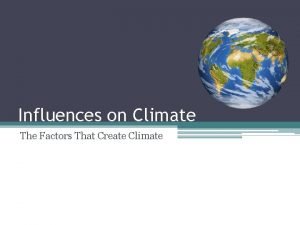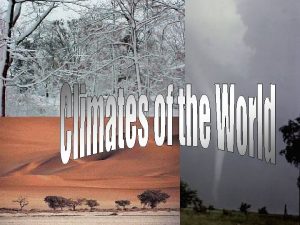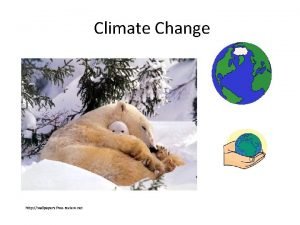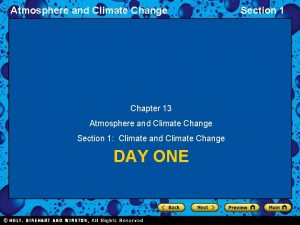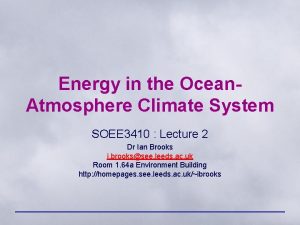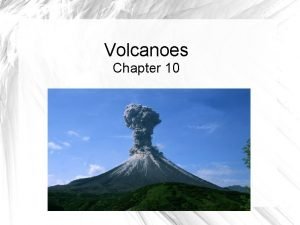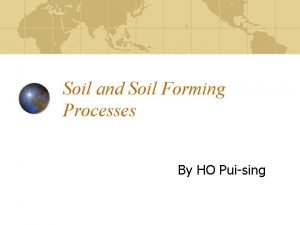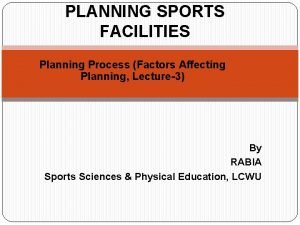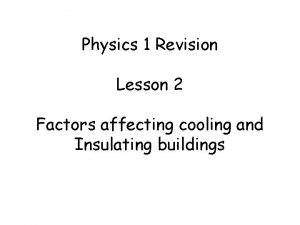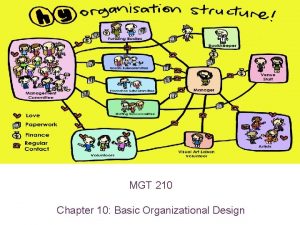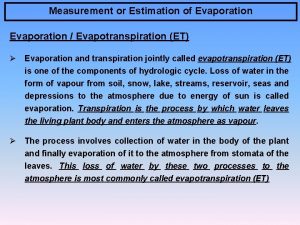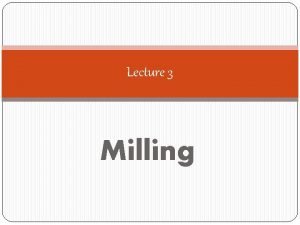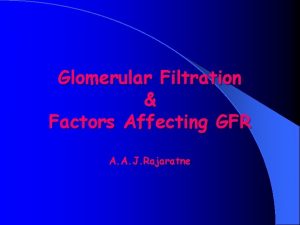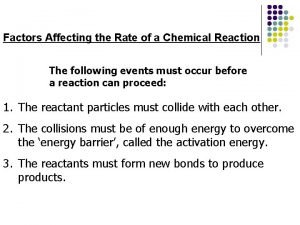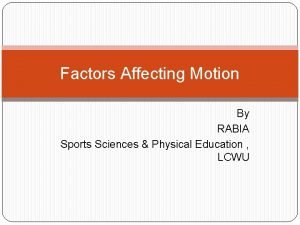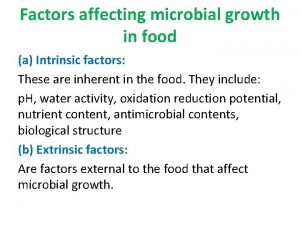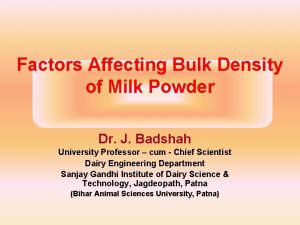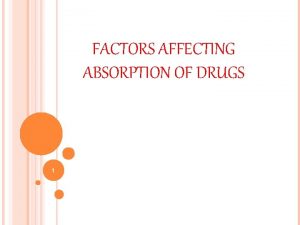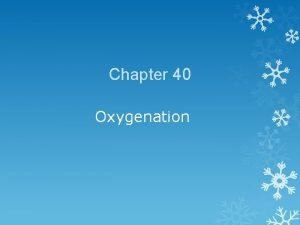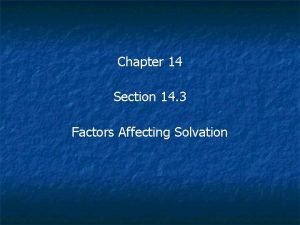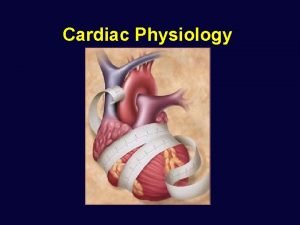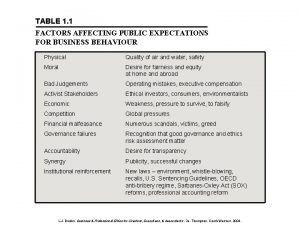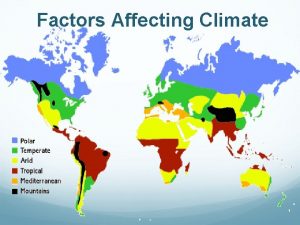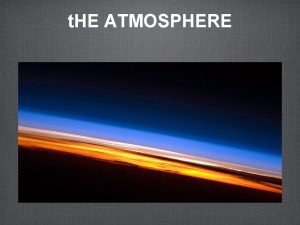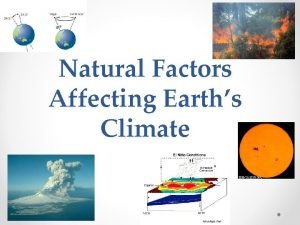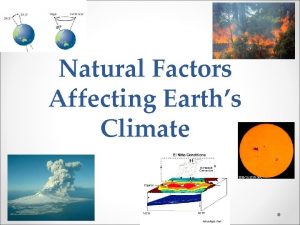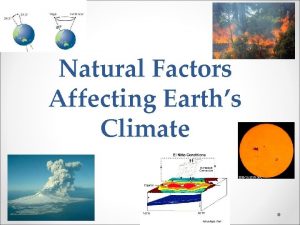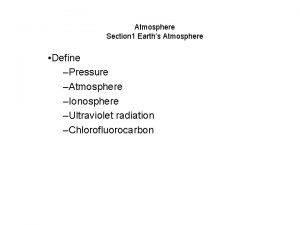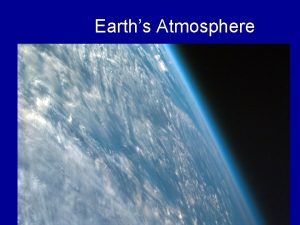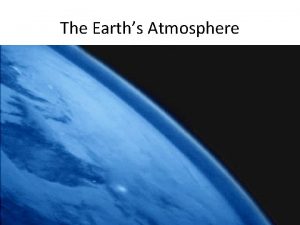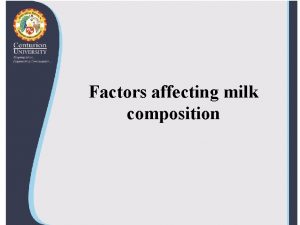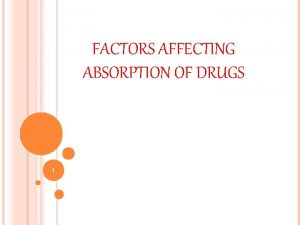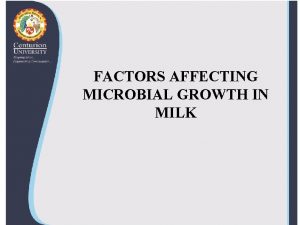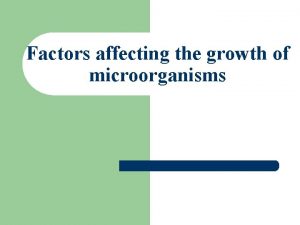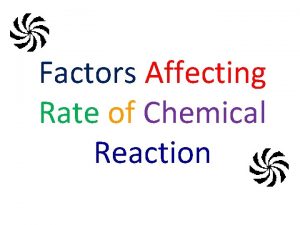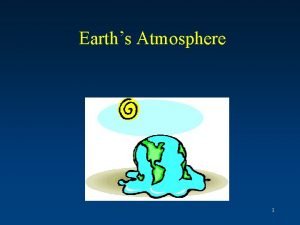Earths Climate System Factors Affecting Climate Earths Atmosphere


























































































- Slides: 90

Earth’s Climate System & Factors Affecting Climate

Earth’s Atmosphere… ► The envelope of gases surrounding Earth, also consists of microscopic dust particles that act as condensation nucleii to allow for condensation & cloud formation

Layers of Earth’s Atmosphere… ► Earth’s atmosphere is layered according to density ► Troposphere, Stratosphere, Mesosphere, Thermosphere, Exosphere all have different properties, conditions


Composition of Atmosphere: § 78% Nitrogen § 21% Oxygen § 0. 9% Argon § 0. 1% Water Vapor, Carbon Dioxide, Methane, Nitrogen Oxides, Ozone, etc. ► Although the last group is only 0. 1%, these are critical to life on Earth! ► Earth’s Greenhouse Effect is caused mostly by the last group!

How is the Earth Heated? ► By the Sun of course! ► Incoming Solar Radiation = Insolation § Most insolation reaching Earth’s surface is in the form of visible light rays! § Lesser amounts of X-rays, gamma rays, radio waves, infrared, ultraviolet make it to Earth, but are typically intercepted by gases in Earth’s upper atmosphere, or shielded by magnetic field


How is the Earth Heated? Earth’s surface is heated unequally by the Sun ► Heat is transferred from warmer areas to colder areas in one of three ways: 1. Conduction = heat transfer through molecular contact; When 2 objects are touching on another, heat is transferred from the hotter to the colder until equilibrium is reached 2. Convection = the circular flow of heat due to density differences ► § Warm air rises (less dense) while cold air sinks (more dense) 3. Radiation = energy moving in the form of waves coming from the Sun § Incoming Solar Radiation = INSOLATION § Most insolation that actually reaches Earth’s surface is in the form of visible light rays (4. 0 x 10 -5 to 7. 0 x 10 -5 cm)

Fate of Incoming Solar Radiation…

How is the Earth Heated? ► Earth’s Greenhouse Effect: ► Earth is heated when visible light rays strike the surface, and energy is absorbed and then re-radiated as infrared heat ► Incoming visible light radiation is a SHORTER wavelength than outgoing infrared radiation. § Gases in atmosphere are transparent to incoming solar radiation (mostly visible light) & allow it to reach Earth’s surface § Visible light strikes earth’s surface, which heats up and emits longer wavelengths of energy in the form of infrared radiation (called terrestrial radiation) § Gases in atmosphere are NOT transparent to outgoing infrared rays, and some of it is re-directed back towards Earth’s surface, thereby heating the troposphere!

Sun’s Electromagnetic Spectrum


Draw Earth’s Greenhouse Effect!

Albedo: the “reflectivity” of a surface ► Earth’s surface varies greatly in the amount of insolation it can absorb § High albedo (very reflective, non-absorbing surfaces) include ice sheets, snow § Low albedo surfaces include pavement, buildings, etc. § Forests and the ocean have low albedo values (perhaps only 5% reflectivity), so they can absorb lots of solar energy!

Natural Physical Factors Affecting Climate: 1. Latitude: • near equator is warm, near poles is cold, because at equator the Sun strikes Earth at a higher angle of insolation, at poles Sun strikes Earth at a lower angle of insolation

Natural Physical Factors Affecting Climate: 1. Latitude…continued: • Seasons on Earth are determined by latitude and angle of insolation at various times throughout the year, and are caused by: Tilt of Earth’s axis ► Earth’s revolution around the Sun ► Parallelism of Earth’s axis ►

Seasons on Earth…

Yearly Daylight Analemma for Poughkeepsie, NY

Yearly Daylight Analemma for Quito, Ecuador

Yearly Daylight Analemma for Melbourne, Australia

Yearly Daylight Analemma for Barrow, Alaska

Yearly Daylight Analemma for the Geographic North Pole!

Natural Physical Factors Affecting Climate: 2. Proximity to a large body of water (ocean or large lake): ► Water has a high specific heat, so the ocean does NOT heat up or cool down easily, and therefore helps to regulate temperatures of nearby coastal areas

Natural Physical Factors Affecting Climate: Nearness to mountains: ► Higher elevations have colder avg. temperatures, longer snowpack, etc. ► Orographic effect: (rainshadow) 3. § Windward side of mountains force air to rise, expand, cool, and cause water vapor to condense, forming clouds and abundant rainfall § Leeward side of mountains experience dry conditions as air sinks…called the “rainshadow” side.

Draw the Windward & Leeward Sides of a Mountain Range

Orographic (Mountain) Effect:

Natural Physical Factors Affecting Climate: Global Wind Circulation Patterns Due to the unequal heating of Earth’s surface, there are major temperature zones on Earth (equator is warm, poles are cold) 4.

Global Wind & Pressure Belts… ► Temperature differences create pressure differences, which cause the wind to blow from areas of high pressure toward areas of low pressure! ► Global wind belts are formed as major convection cells, helping to distribute heat more equally across globe! ► Overall weather and climate patterns are impacted by what global wind belt influences a particular area.

Earth’s major global wind and pressure belts

Natural Physical Factors Affecting Climate: 5. Ocean Circulation Patterns: • Prevailing wind belts create mass movements of ocean water (currents) • Circular ocean currents are called “gyres” • Ocean currents are also influenced by the Coriolis effect, and tend to circulate clockwise in the N. hemisphere, and counterclockwise in the S. hemisphere • Ocean currents are forced to move around major landmasses (continents and islands)

Earth’s Major Ocean Currents

Global Ocean Currents • A warm ocean current approaching a coastline will likely keep nearby temperatures warmer, while a cooler ocean current approaching a coastline will likely keep nearby temperatures cooler than they would otherwise be.

Cold vs. Warm Ocean Currents

Natural Physical Factors Affecting Climate: 6. Ocean-Atmosphere Interactions • The ocean interacts with the atmosphere to dramatically influence climate patterns worldwide • El Nino & La Nina can impact global climate in any given year

El Nino & La Nina Events ► What is an “El Nino” or a “La Nina”? § An El Niño/La Nina event is an oscillation of the ocean-atmosphere system in the tropical Pacific having important consequences for weather around the globe. § This interaction is sometimes called ENSO = El Nino/Southern Oscillation § El Nino & La Nina are the changes that occur in the ocean sea surface temperatures § The “Southern Oscillation” refers to the atmospheric changes occurring, specifically the monthly or seasonal fluctuations in the air pressure difference between Tahiti and Darwin, Australia.

El Nino & La Nina cause major world wide climate consequences: (El Nino Climate Consequences Shown Here)

Normal Conditions in the Tropical Pacific Ocean…

Normal Conditions in the Tropical Pacific Ocean… Typically, strong trade winds (from both North and South), meet up and blow ocean water AWAY from coast of Peru, pushing warm water toward the western tropical Pacific (near Australia) ► This allows cold water upwelling off the coast to replace the warm water that has departed. ► Fishing industry benefits greatly, because cold water upwelling brings nutrients to supply base of elaborate food web! ►

Normal Conditions in the Tropical Pacific Ocean…

El Nino Conditions ► During El Niño, the trade winds weaken in the central and western Pacific leading to a warming of the surface ocean waters in the eastern Pacific (typically off the coast of Peru).

El Nino ► The deeper thermocline results in less upwelling, lack of nutrients, and a loss of productivity and fish! ► The deeper thermocline impacts climate worldwide!

El Nino Conditions…

Recognizing El Nino… ► El Nino can be identified by monitoring Sea Surface Temperatures in the tropical Pacific ocean, using moored buoys (see diagram). ► Buoys send data continuously to satellite, which transmits back to NOAA computers

NORMAL CONDITIONS EL NINO CONDITIONS

El Nino Impacts

La Nina Conditions: ► During La Nina, trade winds strengthen, thereby more effectively pushing warm surface water westward, away from the coast of Peru, and allowing for increased cold water upwelling off the coast, enhancing the productivity and fishing habitats.

La Nina Conditions

A look at all three conditions…

Where did the name come from? ► El Niño was originally recognized by fisherman off the coast of South America as the appearance of unusually warm water in the Pacific ocean, occurring near the beginning of the year. ► El Niño means The Little Boy or Christ child in Spanish. This name was used for the tendency of the phenomenon to arrive around Christmas. ► La Niña means The Little Girl.

La Nina Impacts …

Animated SST Sequence: ENSO

Most Recent ENSO Index

Current Observations of Climate ► Today, a wide variety of instruments have been deployed to continuously measure a large number of climate factors including: § Air temperature § Sea surface temperature § Greenhouse Trace Gas concentrations (CO 2, CH 4, O 3, NO 2, etc. § Response of plants (budding times, size, etc. ) § Response of animals (changes in range, timing of reproduction, etc. )

Current Observations of Climate Change: ► Due to human influence, the Earth’s climate systems are changing as a response to the increased greenhouse gases in the atmosphere caused by the burning of fossil fuels and deforestation of the planet.

Methods Used to Gather Current Data: ► Weather monitoring stations ► Weather balloons § These measure air pressure, humidity, wind direction, wind speed, temperature, dew point temperature on a daily basis § Some now also monitoring atmospheric gas content

Methods Used to Gather Current Data: ► Ocean surface buoys § Measure sea surface temps. , ocean currents direction and speed, etc. ► Data from ships at sea ► Satellites orbiting Earth ► Field observations from ecosystem studies

Effects of Global Warming…What Have We Found So Far? ► An overall 1°C increase (about 2°F) over the past 100 years. ► Sea level has risen consistently since the end of the last ice age (past 18, 000 years or so) ► Antarctic & Greenland ice core data reveal that Earth’s current warming trend outpaces any natural warming trends that have occurred in the past, and are therefore likely the result of human influences (burning fossil fuels & deforestation).


Vostok Ice Core Data:


Effects of Global Warming…What May Happen? The IPCC = The Intergovernmental Panel on Climate Change produces an annual report that outlines new findings, analyzes real-time data, and makes projections about future climate based on various computer models ► The enhanced greenhouse effect and the subsequent warming of the Earth has several major implications for the planet, including: ► § Melting of glaciers and sea level rise (some rise due to thermal expansion as ocean warms, some due to additional water in oceans from melting continental glaciers) § Changes in precipitation patterns § Effects on organisms § Effects on human health § Effects on agriculture § Other potential “surprises”, such as the shutting down of the N. Atlantic ocean conveyor


Tree Ring Studies…

Effects of Global Warming…What Have We Found? ► Melting Ice


Arctic Sea Ice Change… 2005 to 2007

2007 Arctic Ice Video

Effects of Global Warming…What Have We Found? ► Sea Level Rise (Animation)



Effects of Global Warming…What Have We Found? Changes in Precipitation & More Extreme Weather Events

Effects of Global Warming…What Have We Found? ► Certain plants are responding to warmer temperatures by: § Showing signs of stress (disease) § Earlier average budding dates in spring § Shifting their ranges

Leafing Dates of Oak Trees (SE England)

Possible Effects of Global Warming on Beech Trees Beech Future range Overlap Present range Fig. 16 -11, p. 377

What have we found lately? ► Certain animals are responding to warmer temperatures by: § Becoming endangered or threatened as they lose habitat (Polar Bears, Amphibians, etc. ) § Shifting their ranges § Changing their feeding habits, etc.

What’s happening in the oceans? ► Thermohaline Circulation = known as the “oceanic conveyor belt”…it is the mass movement of ocean water by convection as heated, less dense water moves across surface (usually from equator toward poles), while colder, more saline, denser waters move at depth (usually back towards equator) § This circulation is largely responsible for the redistribution of heat across the planet

Thermohaline Circulation…

Thermohaline Circulation…what’s happening? § the overall movement of water in the North Atlantic appears to be slowing down with the influx of fresh water from the Arctic…


Thermohaline Circulation…what’s happening? ► Shutting Down of the N. Atlantic Conveyor Has Huge Climate Implications: § May actually plunge Europe into an “ice age”, since the Gulf Stream may not continue to bring warmth § Could drastically alter marine ecosystems, impacting fisheries worldwide § May trigger more severe climatic events such as hurricanes where water becomes excessively heated § ? ? Remember…we are performing an experiement on ourselves!

Other oceanic changes… ► Sea surface temperatures are getting slightly higher. . . but it takes a LOT of heat energy to increase temps of oceans even slightly (recall water’s high specific heat)

Other oceanic changes… ► Acidification of the oceans…p. H values have decreased by approximately 0. 1 unit in surface waters already due to oceanic uptake of anthropogenic CO 2 (NOAA) ► p. H values may go down another 0. 4 units with expected anthropogenic increases in CO 2 (NOAA) ► Lower p. H values change the carbonate chemistry of the water…and in effect begins to dissolve the shells of marine organisms!

Effects of Global Warming…what’s next? ► IPCC = Intergovernmental Panel on Climate Change predicts that temperatures may increase anywhere from 1. 4° to 5. 8 °C in the next century! ► Warming is most extreme in the Arctic, where record low ice levels have been reported in the past year! ► Crop failures, desertification, and the increased incidence of insect-borne diseases are predicted or are already present! ► Emerging diseases may also be linked to warmer temperatures… ► Economic failure in some areas will impact the entire world…it is a world economy!

Risk of Malaria Transmission Will Increase due to Global Warming…


North & South America Consequences

Consequences for the rest of the world

More heat, more pollen, more asthma, more ozone…


What’s Causing The Enhanced Greenhouse Effect and “Global Warming”? . . . HUMANS! (anthropogenic factors) ► Increases in greenhouse trace gases (GTG’s) have been primarily due to human activities, which are called anthropogenic effects. ► Greenhouse trace gases, include H 2 O (water vapor) CO 2 (carbon dioxide), CH 4 (methane), Nx. Ox (nitrous oxides), O 3 (ozone), and halocarbons like CFC’s (chlorofluorocarbons).
 Earths early atmosphere contained
Earths early atmosphere contained What are the factors affecting the climate
What are the factors affecting the climate What are the factors affecting the climate
What are the factors affecting the climate Factors affecting climate
Factors affecting climate Lesson 2 factors affecting climate
Lesson 2 factors affecting climate Factors that affect climate change
Factors that affect climate change Chapter 13 atmosphere and climate change section 1
Chapter 13 atmosphere and climate change section 1 Chapter 13 atmosphere and climate change
Chapter 13 atmosphere and climate change 5 oceans
5 oceans Ocean atmosphere and climate
Ocean atmosphere and climate How is climate change our health
How is climate change our health Factors affecting microbial growth in food
Factors affecting microbial growth in food Lava plateau diagram
Lava plateau diagram Factor affecting volcanic eruption
Factor affecting volcanic eruption Simple carburetor
Simple carburetor Application of tga
Application of tga V-list link
V-list link Factors affecting the success of multilingualism
Factors affecting the success of multilingualism Five factors affecting human movement
Five factors affecting human movement End diastolic volume meaning
End diastolic volume meaning Factors affecting movement in physical education
Factors affecting movement in physical education Baricity of local anesthetics
Baricity of local anesthetics Puising
Puising Factors affecting health
Factors affecting health Explain the factors affecting chemical equilibrium
Explain the factors affecting chemical equilibrium Factors affecting sample size
Factors affecting sample size Factors affecting the merchandising function
Factors affecting the merchandising function Factors affecting planning in sports management
Factors affecting planning in sports management Factors affecting evaporation
Factors affecting evaporation Factors affecting performance in sports
Factors affecting performance in sports Physiological factors affecting performance
Physiological factors affecting performance Advantages and disadvantages of drugs
Advantages and disadvantages of drugs Cardiac output is determined by
Cardiac output is determined by Factors affecting transportation decisions
Factors affecting transportation decisions Factors affecting span of control
Factors affecting span of control Cross tooth cross arch balance
Cross tooth cross arch balance Factors affecting bacterial growth ppt
Factors affecting bacterial growth ppt Specialization
Specialization Rohwers formula
Rohwers formula Factors affecting milling process
Factors affecting milling process Factors affecting enzyme activity temperature
Factors affecting enzyme activity temperature Factors affecting glomerular filtration rate
Factors affecting glomerular filtration rate Optimum weight gcse pe definition
Optimum weight gcse pe definition Factors affecting fermentation
Factors affecting fermentation Factors affecting fermentation
Factors affecting fermentation Importance of powder flow in pharmacy
Importance of powder flow in pharmacy Human factors in interior design
Human factors in interior design Interior design ppt
Interior design ppt Factors affecting communication process
Factors affecting communication process Local factors of wound healing
Local factors of wound healing Temperature and activation energy
Temperature and activation energy Factors affecting path of a projectile
Factors affecting path of a projectile Population growth factors
Population growth factors Factors affecting organizational structure
Factors affecting organizational structure Factors affecting option prices
Factors affecting option prices Factors affecting momentum
Factors affecting momentum Intrinsic factors affecting the growth of microorganisms
Intrinsic factors affecting the growth of microorganisms Factors affecting interpersonal skills
Factors affecting interpersonal skills Factors affecting human resource management
Factors affecting human resource management Definition of le chatelier's principle
Definition of le chatelier's principle Factors affecting bulk density
Factors affecting bulk density Ph partition theory
Ph partition theory Objectives of a good plant layout
Objectives of a good plant layout Esp
Esp Factors affecting entrepreneurial growth
Factors affecting entrepreneurial growth Factors affecting health
Factors affecting health No. 245 bur
No. 245 bur Crystallinity
Crystallinity Factors that influence consensus
Factors that influence consensus Function of management
Function of management Factors affecting strategic choice
Factors affecting strategic choice Hit another home run strategy
Hit another home run strategy Factors influencing oxygenation
Factors influencing oxygenation Factors affecting fermentation
Factors affecting fermentation Factors affecting inflation
Factors affecting inflation List 20 personal decision
List 20 personal decision Factors that affect solvation
Factors that affect solvation Factors affecting cardiac output
Factors affecting cardiac output Refractory period heart
Refractory period heart Selection of bridge site ppt
Selection of bridge site ppt Factors affecting drug absorption biopharmaceutics
Factors affecting drug absorption biopharmaceutics Factors affecting sleep
Factors affecting sleep Factors affecting stroke volume
Factors affecting stroke volume Determine factors affecting business risk.
Determine factors affecting business risk. Personal factors affecting decision making
Personal factors affecting decision making Valuation of shares
Valuation of shares Insight learning definition psychology
Insight learning definition psychology Where is trh produced
Where is trh produced Factors affecting public expectation for business behaviour
Factors affecting public expectation for business behaviour Factors affecting biodiversity
Factors affecting biodiversity Factors affecting solubility product
Factors affecting solubility product


